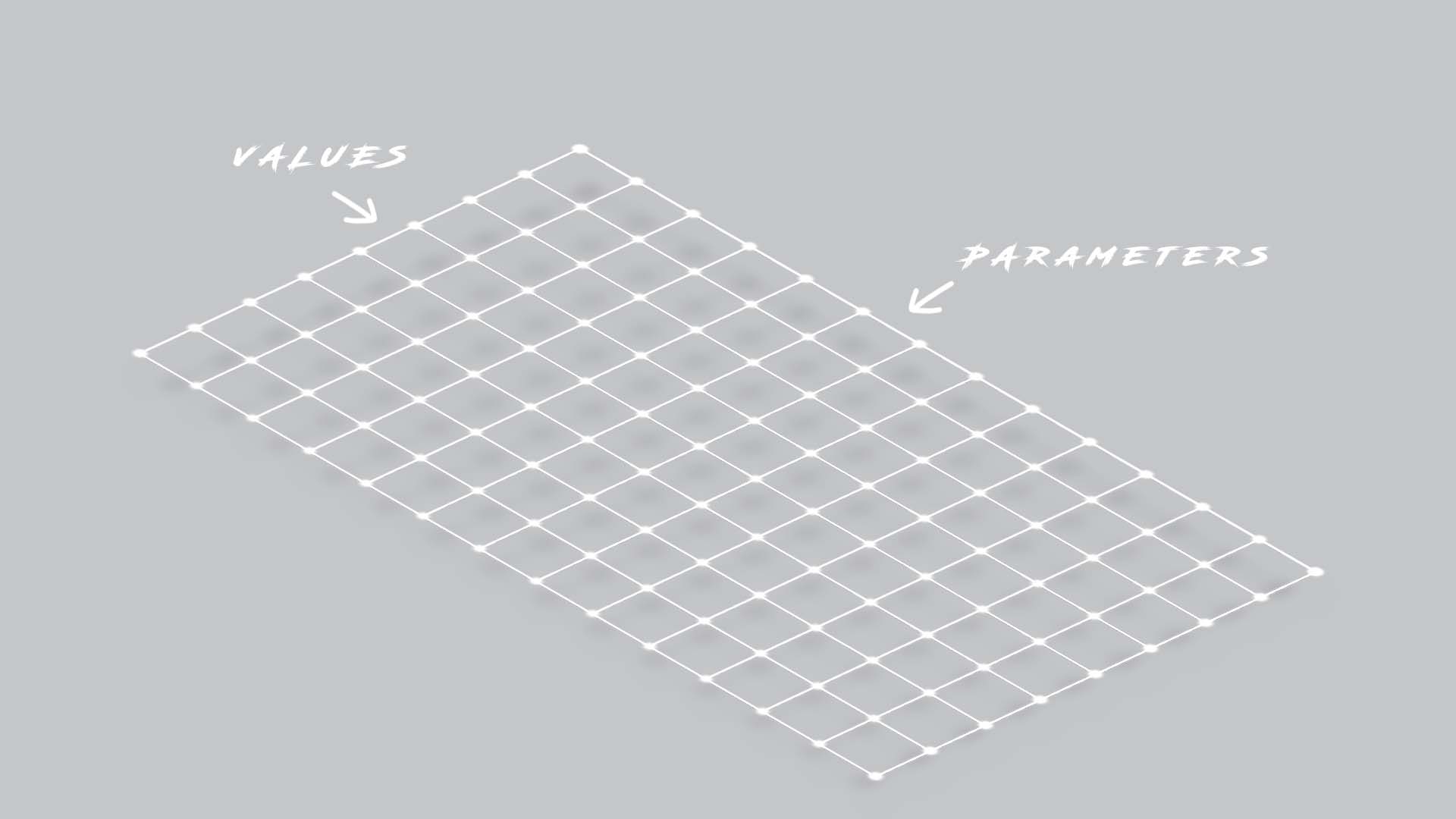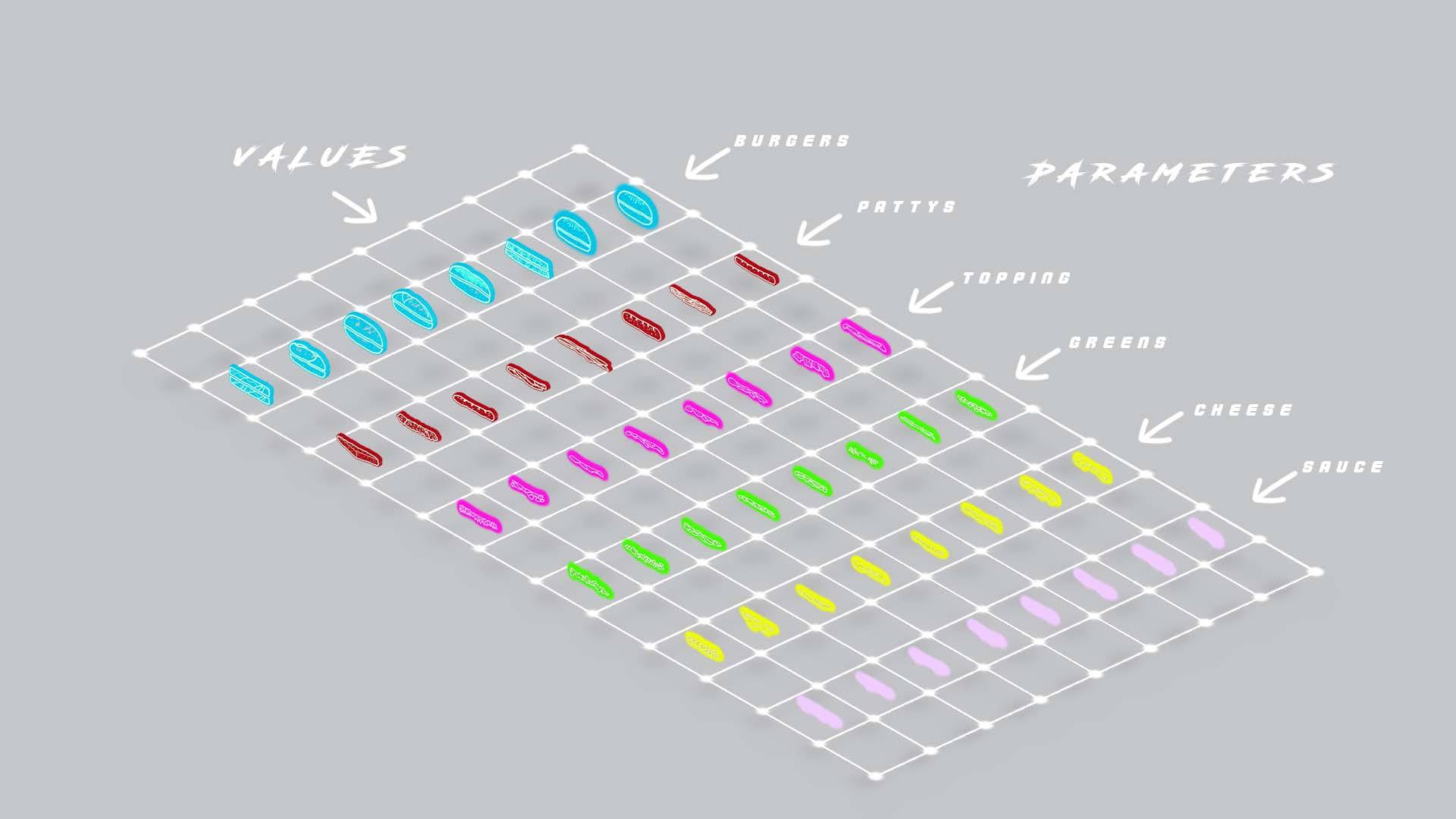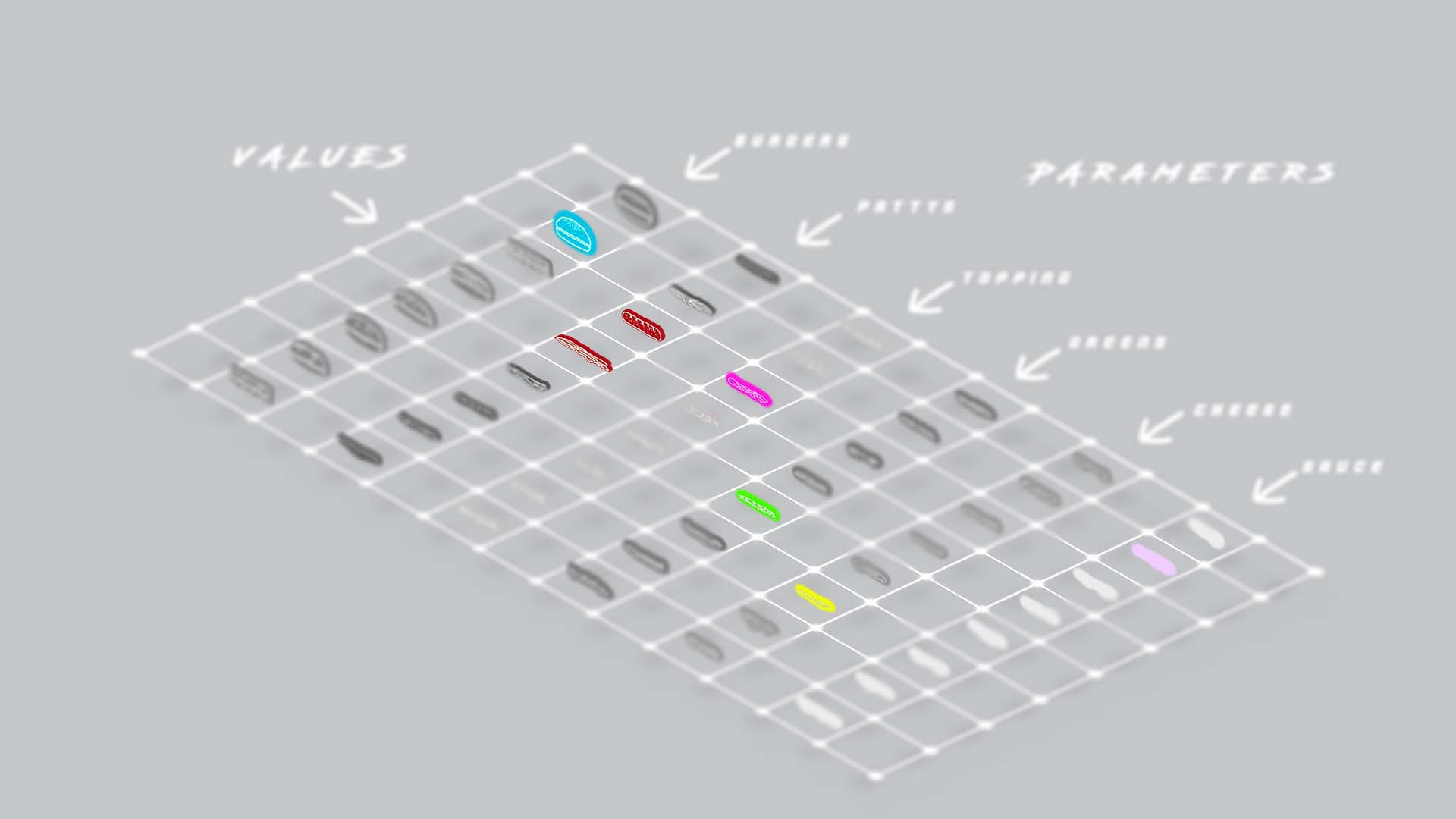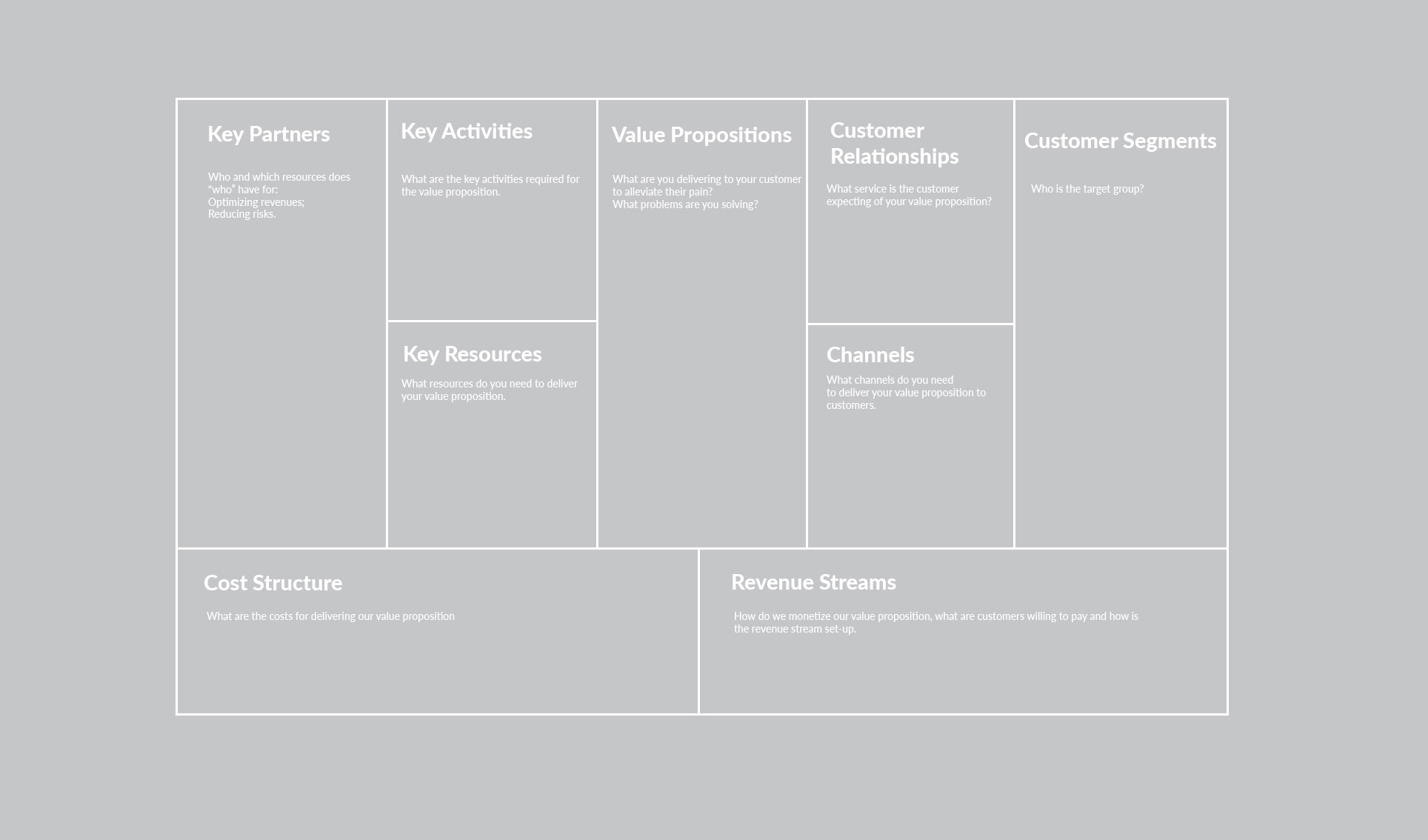Morphological Box
Combine and create something new.

Morphological boxes have been around for quite a while. The initial creation of the morphological box had little to do with business and even less with brainstorm sessions. In some organizations it also goes by the name of “Zwicky Box”. Not to be confused with “Schwifty Box”.
Conceived by the now defunct Fritz Zwicky (1974), he developed the Morphological Box as a method for structuring and investigating the total set of relationships contained in multidimensional, non-quantifiable, problem complexes.
If it sounds complex, it is not supposed to. Zwicky developed the box to solve problems by structuring potential solutions in a grid, so he could quickly identify (a combination of) solutions.
In business a morphological box is used, for example, to solve problems – arising from different dimensions – where data is scarce, where a north-star needs to be found quickly or as a creative method to develop new products or services. However, the box is used more often in social areas, more notably in politics, as the tool helps to identify solutions to complex social problems. In other words, if you are lucky, or unlucky, enough to live in a country where there are a lot of political parties, you could quite literally fill in a grid with all competing solutions for, let’s say, immigration.
In business though, the usage is broad. It can be used for planning (Turley et al., 1975), management (Proctor, 1998), creativity (Proctor, 1998), policy creation (Ritchey, 1998), strategy (Stenström & Ritchey, 2004), decision making (Sharif & Irani, 2006), financial modeling (Petrusel & Mocean, 2007), knowledge transference (Kumar & Ganesh, 2009), business model creation (Lee & Hong, 2011), market innovation (Storbacka & Nenonen, 2012) and prototyping (Seidenstricker et al., 2014).
Now that all the authorship mumbo jumbo is set aside. Let us dig in three different aspects. How to use the Morphological box in a real situation, how it is used in product design and how people have been able to create business models with it.
Using the Morphological Box
Amorphological box is generally used to solve a problem by combining solutions that are already available from different fields. You can do this by dissecting the problem into parameters and adding values that belong to the parameters. If your problem is, lets say, a burger, you could dissect the burger into different parameters. One defining parameter would be, for example, the patty. The values you could include for a patty are beef, pork or soja beans. That is keeping it pretty standard, but you could also include values from other industries, or sub-segments, like a patty made of algae.
In a grid lay down on the left Y axis or top X axis the parameters – that is a defined boundary for the problem at hand. Afterward, add for each parameter the values for possible configurations – elements or values that belong to the parameters. If your problem is more complex, you may need to use of a Z axis and turn the model into a cube instead of a grid.

When arranging all the different parameters and configurations you will create a map. The map allows you to see the different solutions available. You may choose the route that best solves the problem at hand (quite literally). The more configurations (or values) you have the wider the palette of solutions you will create. Try to always add values that can be applied to all parameters as otherwise those values cannot be used across the map. It should be like a slot machine, if you spin all possible solutions, it should “make” sense (although it will rarely hit jackpot).
When the map is ready, you can start drawing the lines for your solution. Just select one to two values from each parameter and continue down to each parameter until you are happy with the solution.
Despite the simplicity of the box it can be difficult to decide when to use it. Some problems may just be better solved with strong data or sound research. In many situations it is even compulsory to further investigate the projected solutions out of a morphological box, as it may not be feasible after all. Rarely will, for example, a business model come out of a morphological box that needs no research. In other words, use the tool as a platform to foment theoretical discussions between participants and not as a decision-making tool.
Using the morphological box in a meeting
Get a whiteboard, different colored whiteboard markers, bunch of post-its, thick markers and some voting dots. Book a meeting room for one hour and add roughly ten minutes extra per person joining.
When the meeting starts, explain how a morphological box works and draw a grid on the white board. Identify the problem and ask the participants to voice the parameters they think should be included in the box to solve the problem at hand. If there are too many participants make sure to use the post-it notes and let them write the parameters that belong to the problem. Give them in between ten to twenty minutes to finish. After, stick the post-its on the wall.
When all the sticky notes are on the wall, it is time to identify the common denominators. With too many parameters, you will be stuck in the room until midnight. Remember, a lot of people will want to write values instead of parameters. It is your job to arrange the sticky notes. Roughly group the notes by topic. After, you should be able to figure out global parameters. If you are lucky and have a few people, you can just write the parameters on the whiteboard.
Afterwards repeat the process for the values or configurations for each parameter.
When finished, you should have a pretty good looking morphological box. Now it is time to select the route on the map. Give the participants each their own colored whiteboard marker. If there are many participants divide it into teams.
Before allowing anyone to draw their proposed map, let them work on a pitch for five to ten minutes. When they are done let them pitch their favorite solution for a maximum of three minutes. Make sure that they draw a line for their favorite solutions.
When every team had time to pitch their preferred solutions it is time for either an open discussion and/or a vote. During the discussion keep it focused on only one solution at a time. If the team that gave the pitch did not draw the line, you can draw it for them. If there are too many lines, you have allowed too many people to work on their solutions and you need the groups to become bigger.
When the discussion is over, draw big circles with every colored marker. Give each person two voting dots. Allow them to stick their vote on the dots. There are no rules for voting.
If there is a standoff and everyone is voting for their competing solutions, allow for people to abstain from voting. Another possible solution is to eliminate the solution that had the least votes and ask the team to vote again.
Product Design

Imagine a fast food chain is rapidly losing market share in a random country. The highest grossing burger of the chain has plummeted twenty percent YoY in the last two years. They have traced the loss in market share due to a change in food consumption in the country. The company wants to gain the market share again and are thinking of different solutions.
The company has investigated the market and have decided that adding another burger to the menu may have better results than launching a marketing campaign. After all, changing people’s habit is harder than changing a menu. At the same time, they need to make sure that they do not cannibalize their current highest grossing burger. More items on the menu means more costs and not necessarily more overall sales.
At this point they need to decide how to approach it further. They have decided that they are going to organize a meeting with a few people involved on different layers of the business and create an initial morphological box.
The project manager that has taken the lead needs to figure something out first before inviting people. Which angle is he going to take for the morphological box?
Take a break. Depending on your background you will have various ideas nested in your brain.
As a market researcher your priority may not be the burger itself, but how the market is segmented and how the supply and demand on sub-segments work. If you would divide the parameters and make a morphological box, you could define the target group better and could more accurately pin-point where to focus resources. When you get right down to it, who said that only one single burger would be able to change the tide?
As a product manager your scope shifts to product development. The target group is important, for sure, but you would rather decide for a list of ingredients and come up with a burger that fits the geographical region. With a morphological box you could put in a list of ingredients and come up with the perfect burger for the area. Plus, you can “easily” test the burger in a restaurant and save valuable resources that would have otherwise ended on market research.
As a marketeer you lean more towards how you are going to communicate the burger. Sure, it needs to taste nice but, more importantly, it needs to sell well. You would be more interested in making something like a Wasabi burger because it will have a hook and will generate attention. With a morphological box you would be more inclined in the ways you are going to communicate the message. Beyond everything, this is a sales problem. If the organization did not lose any market share there would not have been any meeting to start with.
As a purchasing manager you are more concerned about the resources needed for the burger. If you have a surplus of a certain item or you are contractually obliged to purchase more bread buns than you have been able to sell, you will want that specific item to be on the menu. What about sales or shelf life? If the burger does not sell you will have too much stock and if it sells like mad you will be pressed to deliver the raw materials. A morphological box for a purchasing manager, will be more targeted towards, for example, gaining economy of scale or more towards risk management. After all, who said the burger is going to sell?
Now back to the project manager. With so many different angles available which is the correct one? The good and vague – and cheesy – answer is that all the angles mentioned above have their right of existence. However, the project manager can only make one call. Having multiple angles will be out of scope. More importantly, the project manager needs to send invitations to the right group of people.
So, what is the angle then? The angle depends entirely on the problem at hand and what is causing the problem. If the project manager was able to narrow down the problem to a product (hence product design), he can organize the meeting with the people that are responsible for product design. However, product design is already complex and there are many stakeholders that have something to say about it. Selecting the stage for product design will then be important. With the casus explained, we could say that ideation of the burger is the most important now because they can quickly make a selection for the implementation and evaluation. In other words, a morphological box about possible burger would look something like this.

When the morphological box is done, it is time to select the best options to solve the problem at hand. If the country where the chain is operating is seeing an increased number of vegans, it could make sense to develop a vegan burger. On the other hand it may not be related to the burgers at all, people may be able to afford to spend more on expensive burger, maybe a luxury line would solve the issue.

Business model creation
using morphological box theory
Business models are nothing more than a roadmap of how a company intends to create and capture value for stakeholders in a competitive marketplace. If you have read that sentence before, you will likely be familiar with any business model canvas that are running in the wild. Many of those models do a terrific job at explaining the boundaries of a business model and what you need to fill into them. Heck, some models even have a feedback loop built into them, so you can fine tune the model even after using it.
Nonetheless, what most models miss is the actual creation of a business model, the creative part. There are simply not many roadmaps for a structured way of creating an innovative business model. Organizing a brainstorm session with twenty plus individuals will quickly turn into managing a mob and the results will be as innovative as time itself.
Based on the study of Seidemstricker, Scheuerler and Linder (2014), morphological box theory can be used to come up with crunchy new business models. Creating innovative business models does not require a new technical development, although it helps. The elements that constitute the business models can be tweaked with morphological box theory, so that you can come up with a new way of developing your business and gain a strategic advantage. Let me explain.
Get to know a business model canvas (the actual canvas, ESSO, EFQM, etc.), any will do. When you are familiar with a model or you got the model you like, start by dissecting the elements that form part of the canvas. Once that is done you enter the first stage.

The first stage is nothing more than preparing for the second stage. If you have dissected the business model canvas you are about to use, you will likely know what the scope is for each element of the canvas. If you want to keep it structured use the elements as the boundaries they are meant to be. Keep in mind that the elements will be combined with each other at a later stage. It is important that the elements are cohesive with one another. This will also help a lot when you decide to reshuffle the deck.
What you need to be doing during this stage is just come up with ideas. Use any creative process you are accustomed to and write down the things you come up with. If you need guidance try to create just one parameter and start thinking about the values you think belong there. Write all ideas that come up somewhere, it really does not matter if some of the ideas are silly.
Try to look beyond what is necessary to be successful. Look at trends that may influence the business model. Look for fields or other industries that could compliment the business model. The idea behind this phase, is that you will generate quantity and quality ideas, that will eventually lead to parameters and values for the morphological box.
Lastly, during the first stage, define what would make the exercise a success, so you actually have guidelines to assess the end-result on the third and last stage.
The second stage involves arranging the information you have come up with during the first stage. All the things you have come up with, can be a potential option for a parameter or value. Sort and organize the ideas by putting them in a morphological box. In most cases you will need to use multiple morphological boxes. One for each element of the business model canvas you selected before. Do this before entering the last stage.
Do stand still with each parameter and value of the morphological box before entering the third stage. The information in those boxes are designed so that a selection can be made for the business model. If you do not take your time analyzing the options, you can jeopardize the entire exercise as the consistency and the actual quality of the options will lead to poor results. People will also be brain fatigued if they have too many variables that make no sense.
The last stage is having a good look at the morphological box. If you have followed the steps, you will likely have a few morphological boxes hanging around. Now it is time to find the red tape that will create a sustainable competitive advantage.
What you will be looking for is a combination of values that increase the advantages of the business model. You will not magically see the red tape yet, just select a few options and use them as prototypes. Discuss them with your team and come back to the drawing board until you have found the competitive advantage you were hoping was there. Just continue to draft prototypes and discussing prototypes until you have figured it out.
Lastly, when you have a few competing options, check if the advantages fit with your definition of success that you made during the first stage.
Are there flaws to creating a business model this way? You bet there is. The first phase is still a brainstorm session. It is a guided one, but it is still you and your team that come up with the ideas. You will still have to put the hard work into it, there is still no magical remedy for coming up with ideas. Coincidentally, that is also the problem with the last phase. It is a trial and error approach, for which you have to put work into. Lastly, if you select a business model canvas with many elements, you will be dreaming about morphological boxes for a few nights.

Share this Page
References
Álvarez, A., & Ritchey, T. (2015). Applications of General Morphological Analysis. Acta Morphologica Generalis, 22(40).
Im, K., & Cho, H. (2013). A systematic approach for developing a new business model using morphological analysis and integrated fuzzy approach. Expert Systems with Applications,, 40(11).
Kumar, J., & Ganesh, L. (2009). Research on knowledge transfer in organizations: a morphology. Journal of Knowledge Management, 13(4).
Kuriakose, K., Raj, B., Satya Murty, S., & Swaminathan, P. (2010). Knowledge Management Maturity Models – A Morphological Analysis. Journal of Knowledge Management Practice, 11(3).
Lee, J., & Hong, Y. (2011). A Morphological Approach to Business Model Creation using Case-Based Reasoning. Proceedings of the International Conference on Engineering Design (p. ICED 11). Denmark: Technical University of Denmark.
Petrusel, R., & Mocean, L. (2007). Modeling decisional situations using morphological analysis. Informatica Economica, 4(44).
Plauché, M., de Waal, A., Grover, A. S., & Gumede, T. (2010). Morphological Analysis: A Method for Selecting ICT Applications in South African Government Service Delivery. Information Technologies & International Development, (6)1.
Proctor, R. (1991). The Importance of Creativity in the Management Field. British Journal of Management, 2-4.
Ritchey, T. (1998). Fritz Zwicky, ‘Morphologie’ and Policy Analysis”. Proceedings of the 16th EURO Conference on Operational Analysis. Brussels.
Seidenstricker, S., Scheuerle, S., & Linder, C. (2014). Business Model Prototyping – Using the Morphological Analysis to Develop New Business Models. Procedia - Social and Behavioral, Volume 148.
Sharif, A., & Irani, Z. (2006). Applying a fuzzy-morphological approach to complexity within management decision-making. Management Decision, 44(7).
Storbacka, K., & Nenonen, S. (2012). Competitive Arena Mapping: Market Innovation using Morphological Analysis in Business Markets. Journal of Business-to-Business Marketing, 19(3).
Turley, R., Richardson, W., & Hansen, J. (1975). Morphological analysis for health care systems planning. Socio-Economic Planning Sciences, 2.
Zwicky, F. (1969). Discovery, Invention Research - Through the Morphological Approach. Toronto: The Macmillan Company.
Zwicky, F., Wilson, A., & (eds). (1967). New Methods of Thought and Procedure: Contributions. Berlin: Springer.


